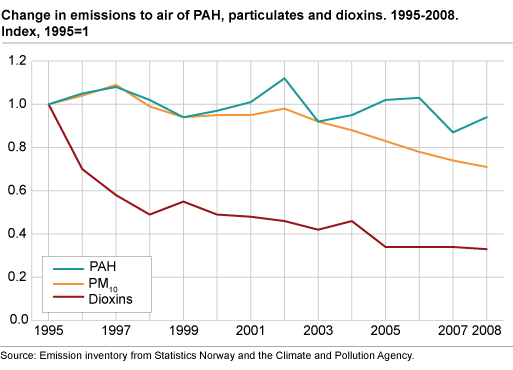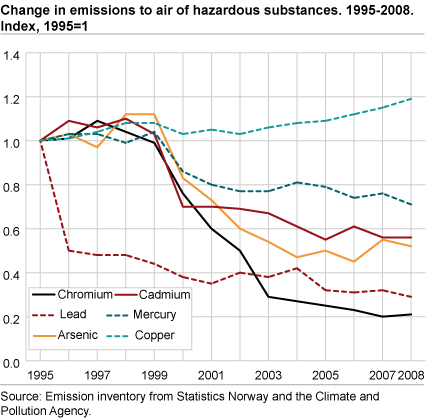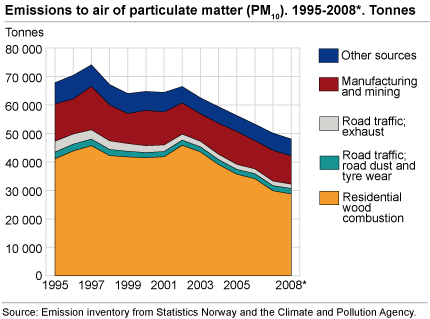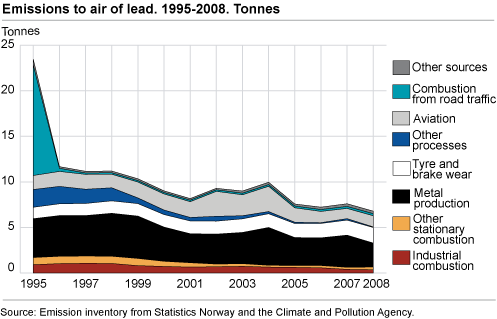Content
Published:
This is an archived release.
Lower emissions of particulate matter
The emissions of particulate matter to air have been reduced by 4 per cent since 2007 and by 31 per cent since 1990. Emissions of most hazardous substances show a continued decline.
The calculations of emissions to air for the period 1990-2008 are performed by Statistics Norway in close collaboration with the Climate and pollution agency.
Reduction in most emissions after 1995
Norway has a national target reducing emissions compared to emission levels in 1995, but these goals are not quantified. Internationally, we have an obligation to reduce emissions of selected hazardous substances compared to 1990. Emissions of particulate matter have been reduced by 31 per cent since 1990. The most important reason is reduced emissions from wood-burning in private households. For most hazardous substances, the emission levels are decreasing. The decrease continued from 2007 to 2008 for most heavy metals and for dioxins. The most important cause of reduction from 2007 was decreasing emissions from the production of iron, steel and ferroalloys. Emissions of PAH, chromium and copper, on the other hand, increased from 2007 to 2008.
The cause of the decrease since 1995 is primarily reduced emissions within industry and mining. Cleaning measures, changes in production procedures and lower activity in some industries have all resulted in reduced emissions. Due to the phasing out of lead-containing petrol, the emissions of lead from road traffic fell dramatically from 1990 to 1996. Fluctuations in emission levels can be affected by uncertainty in measurements.
Emissions of particulate matter is decreasing
Fifty-nine per cent, or 28 400 tonnes, of the emissions of particulate matter in 2008 came from wood-burning . The emissions from this source went down by four per cent from 2007, even though the consumption of wood remained unchanged. The reduction was due to a larger share of stoves with new technology. Industrial processes and mining contributed with 10 000 tonnes, or 20 per cent, of particulate matter emissions in 2008. Emissions from this source have varied between 9 000 and 15 000 tonnes since 1990. Motorised equipment and road abrasion/tyre wear were responsible for five and four per cent of emissions in 2008 respectively.
Annual variations in emissions of PAH
The increase in PAH emissions from 2007 to 2008 was mainly due to increased emissions from aluminium production, and these emissions are subject to large annual variations. In addition, there were increased emissions from the production of iron, steel and ferroalloys. Aluminium production caused 54 per cent of PAH emissions in 2008, compared to 37 and 38 per cent in 1990 and 1995 respectively. Aluminium production has thus gained an increasing significance in the PAH emissions in the period. Wood-burning was responsible for 24 per cent of PAH emissions in 2008, while other dominant sources were road traffic (7 per cent) and solvents (5 per cent).
Lead emissions are still decreasing
There was a considerable decrease in lead emissions in the period 1990 to 1996 due to the phasing out of lead-containing petrol. Emissions from road traffic combustion comprised 90 per cent of total lead emissions in 1990, compared to 52 per cent in 1995 and 3 per cent in 2008. From 2007 to 2008, the emissions of lead were reduced by 11 per cent, mainly due to reduced emissions from the production of iron, steel and ferroalloys. Approximately 40 per cent of lead emissions in 2008 stemmed from production processes in the industries. Other important sources were brake wear and use of lead-containing petrol in light aircrafts, which together were responsible for almost 40 per cent of lead emissions in 2008.
Emissions to air of chromium, arsenic and cadmium greatly reduced
In addition to a strong decrease in lead emissions, chromium, arsenic and cadmium emissions have been reduced by more than 40 per cent since 1995.
Emissions of chromium were almost 2.3 tonnes in 2008. This is a small increase since 2007. Combustion in the wood processing industry contributed with 18 per cent of the total chromium emissions to air in 2008, and is now the most dominant source. Emissions of chromium have been reduced by 79 per cent since 1995. The reduction is mainly due to the shutting down of one industrial company. Emissions from production of iron, steel and ferroalloys have since 1995 been reduced by 96 per cent. Emissions from this source comprised 12 per cent of total chromium emissions in 2008, compared to 72 per cent in 1995.
In 2008, 1.5 tonnes of arsenic were emitted to air. This is a reduction of 6 per cent since 2007. For the past few years, variation in arsenic emissions has been due to varying arsenic content in raw materials and reducing agents used in metal production. The total arsenic emissions have halved since 1995.
Emissions to air of cadmium have remained unchanged since 2007. Emissions of cadmium were 550 kilos in 2008. Wood-burning in private households and burning of refuse wood and waste liquor in the wood processing industry are the most important sources of emissions of cadmium to air. In 2008 these sources contributed with 22 and 21 per cent of total emissions respectively. Cadmium emissions have been reduced by 44 per cent since 1995, and the main reason for this is reduced emissions from the production of iron, steel and ferroalloys due to emission reduction efforts and the closing down of production plants. This source was responsible for 13 per cent of emissions in 2008, compared to 24 per cent in 1995.
Stable mercury emissions
The annual variation in mercury emissions has been minor for the past few years, and from 2000 the emissions have been relatively stable. Emissions were 625 kilos in 2008. The most important emissions source was production of iron, steel and ferroalloys, with 20 per cent of emissions in 2008.
Increasing emissions of copper
In contrast to the other heavy metals, copper emissions are increasing. The increase is due to higher emissions from brake wear and combustion emissions from road traffic caused by increasing traffic. These emissions comprised 46 and 9 per cent of total copper emissions in 2008 respectively. Another important emissions source is metal production, which was responsible for 24 per cent of emissions in 2008.
Dioxin emissions show strong decrease
The emissions of dioxin have been reduced by 67 per cent since 1995. A large proportion of this reduction is due to the shutting down of one industrial plant and one mine. In addition, emissions from waste incineration were reduced by 98 per cent from 1990 to 2008 due to the introduction of cleaning measures. The emissions were reduced by one per cent from 2007 to 2008, due to reductions in emissions from production of iron, steel and ferroalloys and from navigation. The most important emission source in 2008 was wood-burning in private households, which caused 31 per cent of total emissions. Combustion from navigation and metal production was responsible for 19 and 17 per cent of total emissions respectively.
Emissions to air of chromium, arsenic and cadmium reduced by over 40 per cent since 1995
In addition to a strong decrease in lead emissions, chromium, arsenic and cadmium emissions have been reduced by more than 40 per cent since 1995.
Emissions of chromium were almost 2.3 tonnes in 2008. This is a small increase since 2007. Combustion in the wood processing industry contributed with 18 per cent of the total chromium emissions to air in 2008, and is now the most dominant source. Emissions of chromium have been reduced by 79 per cent since 1995. The reduction is mainly due to the shutting down of one industrial company. Emissions from production of iron, steel and ferroalloys have been reduced by 96 per cent since 1995. Emissions from this source comprised 12 per cent of total chromium emissions in 2008, compared to 72 per cent in 1995.
In 2008, 1.5 tonnes of arsenic were emitted to air. This is a reduction of 6 per cent since 2007. For the past few years, variation in arsenic emissions has been due to varying arsenic content in raw materials and reducing agents used in metal production. The total arsenic emissions have halved since 1995.
Emissions to air of cadmium have remained unchanged since 2007. Air emissions of cadmium were 550 kilos in 2008. Wood-burning in private households and burning of refuse wood and waste liquor in the wood processing industry are the most important sources of emissions of cadmium to air. In 2008 these sources contributed with 22 and 21 per cent of total emissions respectively. Cadmium emissions have been reduced by 44 per cent since 1995, and the main reason for this is reduced emissions from the production of iron, steel and ferroalloys due to emission reduction efforts and the closing down of production plants. This source was responsible for 13 per cent of emissions in 2008, compared to 24 per cent in 1995.
Stable mercury emissions
The annual variation in mercury emissions has been minor for the past few years, and from 2000 the emissions have been relatively stable. Emissions were 580 kilos in 2008. The most important emission source was production of iron, steel and ferroalloys, with 20 per cent of emissions in 2008.
Increasing emissions of copper
In contrast to the other heavy metals, copper emissions are increasing. The increase is due to higher emissions from brake wear and combustion emissions from road traffic caused by increasing traffic. These emissions comprised 46 and 9 per cent of total copper emissions in 2008 respectively. Another important emission source is metal production, which was responsible for 24 per cent of emissions in 2008.
Dioxin emissions show strong decrease
The emissions of dioxin have been reduced by 67 per cent since 1995. A large proportion of this reduction is due to the shutting down of one industrial plant and one mine. In addition, emissions from waste incineration were reduced by 98 per cent from 1990 to 2008 due to the introduction of cleaning measures. The emissions were reduced by one per cent from 2007 to 2008, due to reductions in emissions from production of iron, steel and ferroalloys and from navigation. The most important emission source in 2008 was wood-burning in private households, which caused 31 per cent of total emissions. Combustion from navigation and metal production were responsible for 19 and 17 per cent of total emissions respectively.
Differences between emissions to air and local air qualityParticulate matter differs from hazardous substances in the sense that it is primarily a local problem. Thus, there is great variation in how profoundly different local communities are affected. Particulate matter in air contributes to poor air quality locally, but can also be transported over great distances and contribute to background pollution in other locations. It is important to note the difference between emissions to air and local air quality. The figures calculated in these statistics are emissions to air, i.e. the amount of particulate matter coming from the chimney, exhaust pipe etc. This is not to be confused with local air quality or concentrations, which is the amount of substances that is actually breathed by humans. In concentration calculations, the fact that humans are more exposed to some emission sources than others is taken into account. For instance, emissions from wood-burning are often emitted from chimneys, and do not affect local air quality to the same extent as exhaust emissions. For this reason, one tonne of particulate matter from wood-burning is less significant to concentrations at ground level than one tonne from exhaust. The weather is very important for the effect of particulate matter emissions on air quality. The health risks associated with local air pollution depend on how high the concentration of the polluting substances is, and on length of exposure. Asthmatics and people with respiratory disorders or cardiovascular diseases are most heavily affected by air pollution in Norway. In addition, children and young people, pregnant women and the elderly are especially sensitive. |
About the emission inventoryAll emission estimates are burdened with some uncertainty. Due to measuring uncertainty in data reported to the Climate and pollution agency, the uncertainty is particularly high for reported emissions from the industry. This is partly due to low levels of hazardous substances, which makes accurate measurements challenging. In addition, frequent measurements are essential to obtain good estimates when emissions vary with time, and the measurements should often be performed more frequently than what is practically and economically feasible. For more information about the emission calculations, see The Norwegian Emission Inventory 2009. Documentation of methodologies for estimating emissions of greenhouse gases and long-range transboundary air pollutants (Documents 2009/10) Read more about greenhouse gas emissions and emissions of acidifying substances |
Tables:
The statistics is published with Emissions to air.
Contact
-
Statistics Norway's Information Centre
E-mail: informasjon@ssb.no
tel.: (+47) 21 09 46 42




